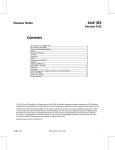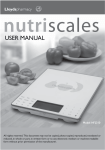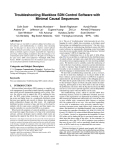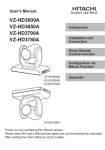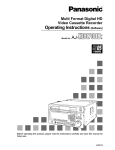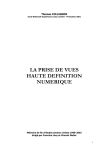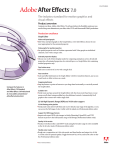Download Avid Technology DS 5.0 Product specifications
Transcript
Avid®|DS Release Notes Version 5.0 CONTENTS Licensing ...........................................................................................................................2 Backward Compatibility ..................................................................................................2 Supported Formats and Decks ........................................................................................2 Drivers...............................................................................................................................3 Computer System.............................................................................................................3 Third Party Plug-ins.........................................................................................................4 3D DVE.............................................................................................................................4 Animation.........................................................................................................................5 Audio.................................................................................................................................5 Compositing and Effects..................................................................................................5 Desktop .............................................................................................................................7 Editing and Playback........................................................................................................8 EDL, OMFâ and ALE.......................................................................................................8 Hardware ..........................................................................................................................9 Media Management, Capture/Output, and Archive/Restore ......................................10 Paint and Titling.............................................................................................................12 Remote Processing .........................................................................................................13 Documentation ..............................................................................................................14 Customer Service Utilities .............................................................................................14 © 1997-2001 Avid Technology, Inc. All rights reserved. Avid, OMF, and Media Composer are registered trademarks, and AVX, Equinox, and Symphony are trademarks of Avid Technology, Inc. All other trademarks contained herein are the property of their respective owners. This document is protected under copyright law. The contents of this document may not be copied or duplicated in any form, in whole or in part, without the express written permission of Avid Technology, Inc. This document is supplied as a guide for Avid|DS products. Reasonable care has been taken in preparing the information it contains. However, this document may contain omissions, technical inaccuracies, or typographical errors. Avid Technology, Inc. does not accept responsibility of any kind for customers’ losses due to the use of this document. Product specifications are subject to change without notice. Printed in Canada. Part No. 0130-05120-01 Avid|DS 5.0 Release Notes • November 2001 1 Licensing The Avid|DS 5.0 system includes new licensing instructions that explain all the installation and troubleshooting steps for your workstation and remote processing station. To access these HTML instructions: From the Start button, choose Programs > Avid Products > Avid DS v5.0 > Licensing Instructions. Backward Compatibility § You can use NTSC and PAL sequences created with the Avid|DS 4.0 system, but you must use the archive/restore tool to bring sequences from earlier versions into version 5.0. § Once you save or archive a project in version 5.0, it cannot be opened using earlier versions of the Avid|DS system. If you need to access the project again in version 4.0, make sure you archive the project in version 4.0 before using projects in version 5.0. Avid|DS RP 5.0 Avid|DS RP 5.0 can handle requests sent from Avid|DS 4.0, as well as version 5.0. If you send a request from Avid|DS 4.0, some effects may not be processed due to changes in the way these effects work in version 5.0. The following effects may be affected: § Keyers: Blue-Green, Chroma, and Linear Luma § Graphics (paint) § Layer DVE using Stabilizer/Tracker, standalone Stabilizer, tracker, and corner pinning effects § Matte and Matte Composite § All time based effects: Timewarp, 3:2 Expand/Contract, and Interlace/Deinterlace § Impressionist effects Note: Avid|DS RP 4.0 cannot handle requests sent from Avid|DS version 5.0. The request will not be processed. Upgrading your Keymappings You can import your customized keyboard mappings from an earlier version of Avid|DS into Avid|DS 5.0. First open the older version of Avid|DS and export the keyboard mapping through the Export/Import preferences. (Note: You can export multiple keyboard mappings at the same time.) Then open Avid|DS 5.0, and import the keyboard mappings. Supported Formats and Decks Formats The Avid|DS system supports the following formats only: § 1920 x 1080 interlaced at 25, 29.97 and 30 fps § 1920 x 1080 progressive at 23.97, 24, 25, 29.97, and 30 fps (segmented frame only) § NTSC and PAL formats Avid|DS 5.0 Release Notes • November 2001 2 Decks Internal tests were performed on the following Sony and Panasonic HD decks: Sony HDW-500 and HDW-F500The HDW-F500 has been certified with all 1920x1080 formats: 23.97, 24, 25, 29.97, and 30 frames per second, both segmented frame and interlace (for 25, 29.97 and 30 frames per second). Like any multi-format device, you should use the preset that corresponds to the frame rate of your sequence. The HDW-500 transport is very similar to the HDW-F500. Panasonic AJ-HD3700This device has been certified for these frame rates: 23.97, 24, 25, 29.97, and 30 frames per seconds. Like any multi-format device, you should use the preset that corresponds to the frame rate of your sequence. The 25 and 29.97 presets are also suitable for operation (525 and 625 lines) with the standard definition version of the Avid|DS system. Panasonic AJ-HD150 and AJ-HD150P (DVC Pro HD format) These devices have been certified for these frame rates: 25, 29.97, and 30 frames per second. Like any multi-format device, you should use the appropriate preset that corresponds to the frame rate of your sequence. The 25 and 29.97 presets are also suitable for operation (525 and 625 lines) with the standard definition version of the Avid|DS system. Note: The 720 progressive format is currently not supported by the Avid|DS HD system. Users have reported using the AJ-HD2700 successfully. In this case, use the HD3700 preset. Drivers Drivers CD Installation Shortcuts If you use Netscape Navigator, you cannot run the shortcut on the CD, since it only allows you to save the files to your system. To work around this, browse the files on the CD to run the removal or installation executable files. Computer System Known Issues Intergraph GT1 system BIOSThe BIOS does not allow you to set the boot device to the AGP graphics card. Because of this limitation, you cannot use a single monitor with the Fire GL1 graphics card. The Avid|DS viewer requires the AGP card to properly display the image information. Silicon Graphics Zx 10 System BIOSIf you reinstall (flash) the computer BIOS, you must access its Configuration Menu (F2) to modify the boot device settings. The BIOS default sets the AGP graphics card as the default boot device, but on an Avid|DS system the boot device must be the PCI card to force it as the left monitor, and to get the Avid|DS viewer on the AGP graphics card connected to the right monitor. Note that the AGP boot device BIOS default is correct if you are using a single monitor configuration with the Zx10. Avid|DS 5.0 Release Notes • November 2001 3 Third Party Plug-ins Please contact the third party vendors directly for availability of their plug-ins. 3D DVE Alpha Processing is Disabled on Clip, Track and Timeline Effects By default, alpha processing is disabled when creating a 3D DVE clip, track, or timeline effect. To work around this, select the Alpha option from the Masking property page (3D DVE/Options property editor). Incorrect Background When Processing with Wildcat 4210 In some cases, the background will be processed with thin black vertical lines. To avoid this, do not render the background in the 3D DVE or select the Allow Tiling for DS Inputs option in the Preferences property page (3D/ DVE Options property editor). Animation Limitations § If more than one object is selected in the 3D DVE layout, the animation editor won’t display its function curves. § The Relative Cycle command (Curves menu) in the animation editor does not work with 3D DVE parameters. To work around this, add a keyframe at the end of the cycle. To work around this, select each function curve individually and “pin” it in the animation editor. Keep pinning all the function curves of the selected object. § When using the global keyframe button to set a key frame on a group, the default group properties are propagated to the grouped objects, changing the non-default values. To work around this, use the Autokey or key frame buttons on the property page of the value you’re animating. § If you copy/paste an animated shape in the 3D DVE Layers view, your animation will be lost. To work around this, use the keyboard shortcuts or the main menu. § In the 3D DVE layout, the animation editor does not update when a parameter is changed in a property editor that is focused on an object that is no longer selected. The Focus icon, in the title bar of property editors, connects a property editor with a specific type of object. Clipping Plane Values Not Saved When you open a sequence that was created with an older version of the Avid|DS system, the Clipping Plane values will revert to their default values (Near=150, Far=5000). Undo Does Not Work if Focus is on Layers View Undo does not work if focus is on the Layers view. To work around this, click on the viewer and undo. Problem with Position Mode in Text Along a Path When using the Position mode in text along a path, you must be in Autokey mode. Problem with a 3D DVE Node Connected to Another in an Effects Tree Whenever there are two DVEs in the data flow path, there may be some refresh problems in the viewer. However, when you process, the results will be correct. Avid|DS 5.0 Release Notes • November 2001 4 Must Click Layer Icon to Select Layer To select a layer, you must click the layer icon in the 3D DVE Layers view. Clicking on the layer name will appear to select the layer, but the previously selected layer will remain active. This may cause confusion when working with layers. Animation Copy/Paste of Function Curves Fails There are two scenarios in which copying and pasting function curves fails: § If you are using the Ctrl+C and Ctrl+V keyboard shortcuts while editing a 3D DVE or shape in the viewer, the DVE and shape editors “grab all the keys.” To work around this, right-click on the animation graph and use the Copy and Paste commands. § Unnoticed selection of a key when: − A single key is selected during copy; the key, not the entire function curve, will be copied. − A single key is selected during paste; the paste will fail. If you want to copy/paste an entire function curve, make sure that no keys are selected in the source or destination curves. Audio Audio Crossfade Activeness Breaks Activeness is broken when you move multiple audio crossfades on the timeline that were multi-selected. The activeness originally set will not be respected. Tail of Reverb Cut after Clip If a reverb effect is used as a clip effect, the tail of the reverb will be cut right after the clip. The audio cache file will not be invalidated if you add an audio effect in an audio container clip. Lost Caches in Audio Container Clips If you change the mixer configuration in an audio container clip, you must reprocess the container clip the next time you load the sequence. Audio Live Capture Limitation with the Equinox Break-Out-Box You must feed a valid video input to the Break-Out-Box in order to perform a live audio capture, otherwise the audio input is muted. Compositing and Effects Mute Background in Composite Node Now Composites with Transparent Black Switching off the Mute Background setting in any newly created Composite node will now composite with a transparent black image (RGBA of 0, 0, 0, 0). Old versions of this node, when saved as a preset or sequence tree, will continue to use opaque black (0, 0, 0, 255) to maintain the previously processed results. Avid|DS 5.0 Release Notes • November 2001 5 Incorrect Results/Errors with Depth of Field and 3D Fog Effects § Since the depth information is not timewarped, incorrect results will be produced if you apply the Depth of Field or 3D Fog effect to a timewarped clip. § There must be a one-to-one mapping between depth files and frames in the clip. When a single rendered frame is trimmed out in the Avid|DS system, the number of frames increase but a single .Zpic file remains, causing an error message to appear. If you want to use a single frame image with the Depth of Field or 3D Fog effects, copy the file as many times as you want it to be displayed, and number each file. For example: MyClip.1.pic, MyClip.2.pic, and so on. Undo Limitations § When you change any parameter settings in the 3D Warp effect, you cannot undo the changes. § When you change properties using the interactive tools of AVX plug-ins, you cannot undo the changes using the Ctrl+Z keyboard shortcut. § Replacing some Effects Tree presets from the Effects Tree property editor may cause problems with undo. Bypass Limitations § When two or more property editors are open in the Compositing layout, bypass may not work if it's selected on multiple property editors. If bypass doesn't work, close one of the property editors or bypass the effect on a layer by deselecting it. § When you select multiple nodes in the Effects Tree view, including a source generator, the bypass keyboard shortcut (B) or Bypass command (on a node in the selection) will not always function. To work around this, remove the source generator from your selection. Source Generator Effects Require an Input when Used in Effects Tree In the Effects Tree, some generated source clips, such as a gradient, timecode, or 3D Warp, require an input. To work around this, add a black source-generated clip as the input to these effects. 3D Warp May Cause System Failure when Using Wave Scene Copying or razoring clips using the 3D Warp Wave scene may cause a system failure in the Avid|DS system. Ghosting in Viewer when Using DVE with Motion Blur When using the Motion Blur option of the DVE, a ghosted image of the original position may sometimes appear in the viewer. This is only a temporary refresh problem, which is corrected once you set a keyframe. Flicker/Deflicker Effect Problem with Fast Flicker Rates Since the reference regions of the black and white luminance levels are computed on a frame basis, there may be problems when the flicker rates are faster than the frame rate. To work around this, deinterlace the source material before you apply these effects. Transition Property Editor Missing Controls When you expand an Effects Tree view and load a transition in a transition property editor, the property editor may not display all the controls. To work around this, reselect the transition (either on the timeline or in the tree). Avid|DS 5.0 Release Notes • November 2001 6 Force Overlay Key Option Does Not Work when Opening New Sequence When the Force Overlay Key option is selected in the Sequence Preferences dialog box and you open a new sequence, the option does not take effect. To work around this, deselect the Force Overlay Key option and click OK. Now select the option again and click OK again. Keep Original Alpha Option Ignored When the Output Matte option is selected in the Shapes property page of the Matte effect, the shapes are applied to the RGB channels and the alpha channel becomes opaque. The Keep Original Alpha option is ignored. Temporary Cache Loss Scenario with the Unfold Action A rendered cache may be invalidated when you unfold a folded tree node that contains some plug-in effects. The cache is recovered when you refold. Wrong Image Display in the Viewer If the bottom-most layer is selected in the Layers view in the graphics container, in some cases the viewer may not show the correct composited result. You can refresh the viewer correctly by selecting any other layer and changing frames. Note that the processed result will be always correct. Desktop Cannot See the Comparison Buffer in the External Monitor Unless the marker ribbon is red at the current frame, you cannot see the comparison buffer in the external monitor. To make the comparison buffer visible, apply an effect temporarily and mask out all of its color channels (RGB). The marker ribbon will turn red over the unprocessed effect, and you will see the comparison buffer in the external monitor for the duration of the effect. Changing the Font Size in Dialog Boxes If you work on non-European customized Windows, such as Windows NT Japanese, you can use the DSFontSetting.exe application, which is distributed with Avid|DS 5.0. Using this application, you can change the default font used in Avid|DS dialog boxes or reset it to the default. Older versions of the Avid|DS system won't be affected by this application. This new font is used only in dialog boxes; menus and toolbar buttons are not affected by this new information. You can customize the menu font size through the Windows Appearance tab of the desktop properties. For non-European languages, the Avid|DS system selects a font (by default) that comprises the European character set and is part of the character set of the foreign Windows system, such as Windows NT Japanese. However, the chosen font is very small and does not appear properly, especially in dialog boxes. For regular systems, the default font for dialog boxes is Arial 11. Note: This application does not ensure that the font will fit properly in the dialog box. Whenever the new selected font is too large for the various text controls of the dialog box, a smaller default font will be used as in previous versions. You must be careful to choose a font that still contains the European character set, since the displayed text is still English. This new feature is not restricted only to Asian systems; any customer of any country can change the Avid|DS default font. However, layouts work best with the actual default font (i.e. Arial 11). Each time a new font is set or reset, you must restart the Avid|DS system before it takes effect. Avid|DS 5.0 Release Notes • November 2001 7 Additional tips: § For best results, use a font size between 8 and 14 points. § If the font selected is a little too big (to be displayed in its designated area), it will be substituted by the default font size. § If the font is way too big, the layout will not appear correctly, and you may need to refresh the screen. Editing and Playback Frames Dropped when Playing Back Still Images If your video storage is heavily fragmented, the Avid|DS system drops frames when playing back still images. To avoid this, defragment your video storage on a daily basis. If this problem occurs with a particular clip, you can defragment that clip alone. 1. Right-click on the clip and choose Show Media. 2. From the Media Manager view, right-click on the .gen file and choose Defragment. Corrupt Images in the Output Monitor when Switching between Sequence Formats When switching sequence formats between the high and standard definition versions of the Avid|DS system, the display in the output monitor may sometimes become corrupted. To correct the problem, simply exit and restart the Avid|DS system. EDL, OMFâ and ALE CMX/GVG EDL Format Detection When loading an EDL file, the File Open dialog box lets you select a format, such as CMX or GVG. With this information, Avid|DS tries to validate your choice in relation to the contents of the file. However, the only marker available for differentiation is the presence or absence of FCM lines in the EDL file. While the presence of FCM lines indicates without a doubt that it is a CMX file, the converse is not necessarily true. Therefore, it is possible to load a CMX file as GVG or vice versa, with unpredictable (but generally wrong!) results. If the EDL file you loaded is not what you expected, verify that you specified the right format for its contents. EDL Only Shows One Stream of Multi-stream Clip on Timeline to EDL A multi-stream clip, such as a 5.1 audio container clip will only show one mono stream in an EDL constructed from that timeline instead of the expected six streams. One-sided Transitions Not Completely Supported EDL and OMF effects with one-sided transitions are imported in Avid|DS as clip effects (just like previous versions of Avid|DS). OMF Reverse Timewarp Limitation from Avid Media Composer and Avid Symphony The OMF files exported from the Media Composer and Symphony systems do not contain any negative speed value information for the timewarp effect. Avid|DS 5.0 Release Notes • November 2001 8 Parameters of AVX Plug-ins in 24p OMF Files Do Not Conform 24p OMF files created by the Media Composer and/or Symphony systems do not contain parameter information for AVX plug-ins. When you import this kind of OMF file into the Avid|DS system, the AVX effects are recreated at the correct location, but all the parameters are at their default values. No entry is added in the OMF log. Hardware Avid Equinox Update This update should be performed on IBM ZPro systems ONLY, not on Intergraph GT1 or SGI Zx10 systems. Incorrect Reports of Equinox Video Subsystem Version by System Diagnostic Utility Depending on your system, the following may be reported by the System Diagnostic utility. Either of these are correct, and you can ignore the red warning light displayed for this driver. § Wensleydale: 2.46 or 162.70 § Monterey: 3.124, 3.35, or 3.39 Video Synchronization Issue with the Equinox Break-Out-Box If you eject a tape during a capture session, horizontal or vertical synchronization shift may occur. To prevent this, do one of the following: § Set the deck to read an internal test pattern image to prevent the synchronization from breaking, or § Feed the deck with a valid SD or HD video signal image. Equinox Break-Out-Box Limitation if Used with a Routing Switcher You may experience a jittery or absence of video signal if you are using the Equinox Break-Out-Box with a routing switcher. You may be required to install video reclocker devices at the input and output of your video signal to eliminate the problem. Hardware Synchronization Status The Hardware Synchronization Status indicator on the status bar is green when the audio/video signals are in sync with the external source. If the system is running on an internal sync clock, the sync status indicator turns an amber color, indicating that the video and/or audio signals are in sync with the internal clock. If the indicator turns red, it means that the signals are out of sync. Support for NTSC-J Analog Output You can now set the analog outputs (composite and S-VHS) of the Equinox Break-Out-Box to NTSC-J. Contact Avid|DS Customer Service if you want to turn on this feature on your break-out-box. Bad or Incorrect House Sync Signals are Detected and Not Used If you have a bad or incorrect house sync signal, the Genlock LED on the Equinox Break-Out-Box blinks and Avid|DS switches to the internal sync signal generated by the Equinox Break-Out-Box. Support for JL Cooper External Controller Is Not Installed by Default Before you can use the JL Cooper External Controller, you must enable it. Avid|DS 5.0 Release Notes • November 2001 9 1. Go to Start > Programs > Avid Products > Avid|DS v5.0 > Setup. 2. In the Welcome dialog box, select Modify and click Next. The Select Components dialog box is displayed. 3. Select the Support for JL Cooper option and click Next. The JL Cooper support files are added to your system and the Maintenance Complete dialog box is displayed. 4. Click Finish. Media Management, Capture/Output, and Archive/Restore Clip Properties Not Inherited from Version 4.0 If you have both Avid|DS 4.x and 5.0 installed on your workstation, make sure that version 5.0 was the last one installed. If not, you cannot see the clip properties when you right-click on a clip. To fix this problem, uninstall and reinstall version 5.0. 23.97 Format Needs Tri-level Synchronization Signal A proper tri-level sync is mandatory when working with the 23.97 format, since the Avid|DS system cannot, at the moment, synchronize internally. Without a tri-level sync, your captured media may be corrupt or you may encounter frame accuracy problems. Disable Viewer if You Encounter Problems while Capturing/Recapturing from Tape If you encounter problems capturing or recapturing material from tape, you should disable the viewer using the Viewer button in the status bar and try capturing again. To avoid any problems, the viewer is disabled by default when capturing full resolution HD material at 29.97 and 30 frames per second. At Least One Audio Storage Must Have ID=1 The Avid|DS storage utility automatically sets up an audio storage area with an ID of 1 during installation. You can add new storage areas or modify/delete existing storages, but make sure that there is at least one audio storage set with an ID of 1, or you will not be able to start the Avid|DS system. Avid|DS 5.0 Release Notes • November 2001 10 Live Capture Is Not Frame Accurate Live captures are not frame accurate. They can be off by +/- 1 frame. Capturing Files Using Standard Graphics Formats The Avid|DS system supports the capture of still images encoded in a large variety of industry-standard formats. These files must conform exactly to the supported standard formats. The Avid|DS system does not support file formats that are “encapsulated” or augmented by third-party applications. If you encounter problems capturing an image and are certain that it’s in a format supported by the Avid|DS system, try resaving a new copy of the file using a well-known graphics editor, such as Adobe Photoshop, to create a readable file. Cannot Import MPEG-4 Format Files The Avid|DS system cannot import MPEG-4 files. To use an MPEG-4 file, you must convert it with a third-party application. Raster Paint Generated Files Files generated by raster paint (.gen files) will not be seen in the Media Manager or Purge dialog box. They will be deleted when the project is deleted and archived when a project is archived. Linked Clips Do Not Process Linked clips with real-time effects in the overlay track(s) do not process. If clicking the Process indicator does not produce any result, try clicking it a second time. Processing should proceed as usual. System Failure when Restoring Media It is currently not possible to restore the PAL or NTSC media (525 or 625 lines) of a standard definition archive inside an HD sequence. You can restore standard-definition media inside a PAL or NTSC sequence. Restoring only the project data causes no problem in any type of sequence. You can also further recapture from original tapes afterward without problems. You can keep both resolutions inside the same master clip or sequence. Archiving Standard Definition and HD Material in the Same Archive The Avid|DS system cannot archive media that consists of the same frame rate but of different resolution. For example, a project that contain 1080I , 29.97, and NTSC material will not archive correctly. To work around this and to create the highest resolution archive, purge the material at a lower resolution before archiving. Alpha of Archived Media Appears in Different Colors The alpha portion of archived media appears as a purple frame, instead of white for positive and green for negative (instead of black). This is normal behavior during restore; the captured images will be fine. Custom HD Sequences Always Import Alpha When converting HD sequences to Custom, The Avid|DS system always recaptures clips with their alpha component whether the Keep Alpha option is selected or not. The clip will appear to have a full white alpha, but show its actual alpha once recaptured with the Custom option. If needed, you can create a full white alpha by adding an effect, such as Alpha Fade or Color Correction to the clip. Avid|DS 5.0 Release Notes • November 2001 11 Capture from File with Preserve Alpha Option Always Results in Filled Alpha The media conversion modes in the Media Input/Output layout allows an image to be scaled during conversion. If the resulting scaled image is smaller than the current sequence resolution (usually with modes supporting "keep original size"), the difference is filled with black pixels. In this situation, when the Preserve Alpha option is selected, you expect that the alpha would only cover the image and the black pixels would be considered transparent. However, Avid|DS 5.0 marks the whole image as being covered by alpha, not just the non-transparent black portions of the image. To work around this, link the image instead of capturing it and alpha will be correctly handled. Paint and Titling Import Limitations § You can import a subset of the Adobe Illustrator EPS format. Only the shape and color information is imported. § You can import HTML text and basic formatting information, such as font style, color, and tabulations (as HTML tables). This does not, however, include other HTML tags, such as images, forms, or scripts. Recent versions of word processing software, which add XML markup tags along with HTML, are not supported. We recommend that you use earlier versions as XML is not yet supported. Raster Paint Limitations § The .gen files generated when burning frames are managed on a per project basis, so deleting or not saving sequences that contain burned frames may leave orphaned .gen files. To help track and delete these files, enter a name in the Base Cache File Name text box in the Graphics property page, use the rastered frames tooltips in the Graphic Object View (GOV), or use the Save option when right-clicking on the rastered frames in the GOV. Deleting a project will also destroy all associated burned frames. § Presets of graphics sessions that contain burned frames cannot be reloaded in sequences that have a different resolution or frame rate. § The burned frames of graphics sessions become opaque. Changes to any effect underneath a graphics session will be ignored for those frames. § Burned frames are not visible when a paint sequence is used as a proxy (Alt-drop from browser). To work around this, select the Non-real-time option and process. Artifacts in Interactive Display of Effects The interactive display of the following effects contain very noticeable artifacts: § Brushes: Bas Relief, Chrome, Glass, and Textured. § Keyer: HLS Keyer with the Fast Blur option selected. These artifacts appear only during interactive display, not when the frames are processed. To work around this, exit the graphics session, make sure the play cursor is not over the graphics session, purge memory caches, and process. Display Quality May Decrease if Viewer Resized to Less Than D1 Resolution If you resize the viewer to less than D1 resolution, the image in the viewer will also resize. This may decrease the image quality. The viewer is resized if you edit the default layout and make the viewer smaller than D1, or if you work in Non-square Pixels mode. In both cases, an exclamation point (!) is displayed at the bottom-right of the viewer to indicate that you are not viewing the image at D1 quality. Avid|DS 5.0 Release Notes • November 2001 12 Composited Graphics Effect Seen Only in Editing Layout When you apply a Graphics effect to a clip in the overlay track, the Graphics layout is displayed. In this layout, the viewer displays the graphics you apply to the clip on the overlay track, but it will not display the final composite. To view the final composite, you must switch back to the Editing layout. Floating Viewer and External Monitor Do Not Refresh Properly with Wireframe Tool When working with the wireframe tool in the Graphics layout, you may encounter refresh problems with the viewer and external monitor. As a workaround, modify a graphic by moving it or changing the color or brush size, and then use the Undo command to return to the previous state. Processing Real-time Graphics May Produce Low Quality Output The quality of the output can be affected when processing real-time Graphics. The workaround is to force the Graphics effect to be non-real-time. To do so, select the Non Real-Time option on the Graphics property editor. Artifacts on Real-time Graphics Objects Over a Background of Similar Color If a Graphics effect contains real-time graphics objects over a background of a similar color, artifacts may appear on those graphics objects. To work around this, force the Graphics effect to be non-real-time by selecting the Non Realtime option on the Graphics property editor. You can also process while you’re in the Graphics layout. Cache Lost After Processing Graphics Shape Animation After processing a Graphics effect that contains shape animation, the cache is sometimes lost when saving and opening the sequence. The workaround is to save your sequence before doing any processing. Remote Processing Avid|DS RP should be Set Up as an Avid|DS RP-only Workstation You must install the Avid|DS RP-Only version of Avid|DS 5.0 on workstations that are to be used as remote processing stations. The only exception to this are other Avid|DS workstations, which have the appropriate hardware. In other words, to use an Intergraph GT1 or SGI Zx10 workstation as a remote processing station, you cannot have the full version of Avid|DS installed, only the Avid|DS RP-Only version. Linked Clips Need Special Attention for Correct Remote Processing To process linked clips, the path of the link must be a full UNC path, including the workstation name and share name (example: \\workstation name\public folder\path …). Alternatively, you can copy the file into your project before importing it in the Media Input/Output layout using the Link option. Otherwise, the remote processing station cannot access the linked file. To work around this, process the link locally (so it can be played in real time) before adding effects to it. Once linked clips are processed, the sequence can be processed remotely. Network Problems during Remote Processing If a network problem or slowdown prevents Avid|DS RP from reading the images to be processed, an error message similar to the one below, will be displayed in the server window. If you receive this message, resend your request. Error occurred while rendering sequence Cache testing_1_2_114352_rpr\\Exported\timewarp for remote processing to dsrt-1 at 2001-02-01 11h36.11.Segment: , error code=-2147467259. Avid|DS 5.0 Release Notes • November 2001 13 Documentation New Features Tour 5.0 The video clips contained in the New Features Tour include an audio narration. If you’re viewing these clips on an Avid|DS workstation, you may need to connect headphones or a second set of speakers to your workstation's audio jack to hear the narration. Note that you must use the on-board Audio PCI card connectors instead of the Merging audio card. Documentation Library To view the PDF files in the documentation library, you must upgrade to Acrobat Reader 5.0. The Adobe Acrobat install program is available on the Avid|DS software CD in the \acrobat folder. Customer Service Utilities Updated Utilities Customer Service has reworked some of the utilities and you might want to take a look at them by starting the Avid|DS Utilities Information HTML pages. From the Start button, choose Programs > Avid Products > Avid DS v5.0 > Customer Service > Avid DS Utilities Information. Avid System Test for the Equinox Video Subsystem Consult the AvidSysTest.html instructions in the <install path>\Avid\Equinox Diagnostic folder for details about the usage and limitation of this test utility. Avid|DS 5.0 Release Notes • November 2001 14














